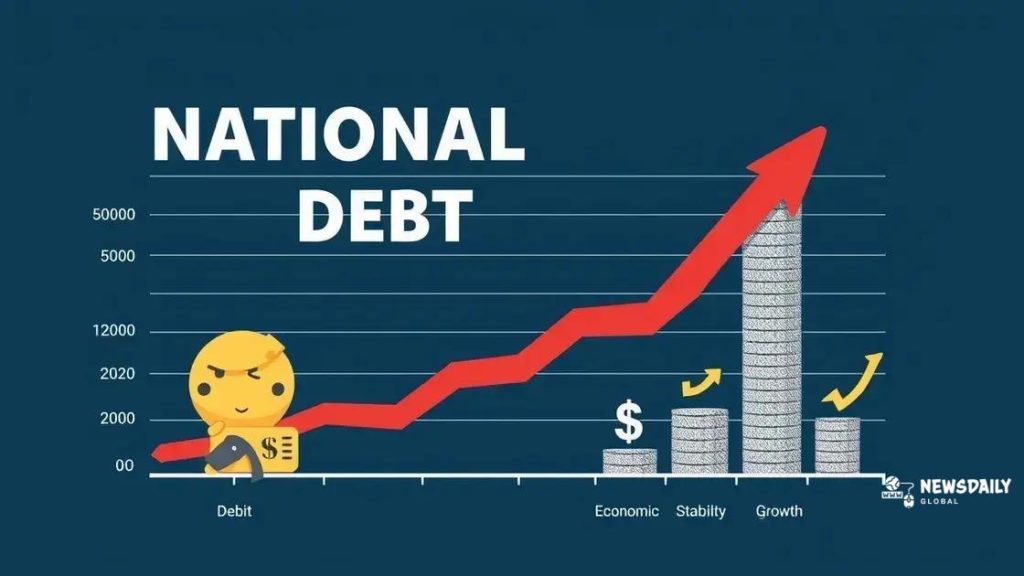National debt hits 125% of GDP: key impacts on the economy

The national debt is the total amount owed by a government, impacting economic growth and stability, with management strategies including fiscal responsibility and fostering economic growth.
National debt hits 125% of GDP—this headline might sound alarming, but what does it truly mean for our economy? As we delve into this topic, consider how such levels of debt could influence everything from government spending to interest rates. Are we prepared for the consequences?
Understanding national debt and GDP
To understand the relationship between national debt and GDP, we need to start with the definitions of each term. The national debt is the total amount of money that a country’s government has borrowed. This debt is often expressed as a percentage of the nation’s Gross Domestic Product (GDP). GDP represents the economic output of a country within a given period, typically calculated annually.
When we say that national debt is a certain percentage of GDP, we gain insights into how manageable that debt is. For example, if a country has a national debt that hits 125% of its GDP, it means that the country owes more than its entire output for a year. This high ratio can raise alarm bells, but understanding its implications requires a closer look.
Historical Context
Historically, many countries have experienced fluctuations in their national debt levels. World events like wars, economic crises, and major policy changes can impact national debt dramatically. It is essential to consider how these historical trends relate to current economic health.
Implications of High National Debt
A national debt that exceeds 100% of GDP can have several consequences:
- Higher interest rates due to increased borrowing costs.
- Potential for reduced government spending on vital public services.
- Increased risk of inflation impacting the economy.
- Future generations may face challenges in managing this debt load.
Furthermore, investors often view high levels of debt as a risk factor, which can lead to reduced confidence in the economy. On the other hand, some economists argue that if debt is used to finance growth, it might not be as concerning.
When considering the ratio of national debt to GDP, policy makers should look beyond the numbers. They need to assess the overall economic landscape, including employment rates, economic growth, and consumer confidence. These elements play a crucial role in determining whether high national debt is a sign of trouble or an opportunity for growth.
Historical context of national debt levels
The historical context of national debt levels provides crucial insights into how countries manage their finances over time. Understanding this history helps us grasp current economic challenges. For instance, during significant events like the Great Depression or World War II, many nations saw their debt levels rise sharply.
In the aftermath of World War II, the global economy faced enormous pressures, leading to heightened national debts across many nations. Countries incurred debts to rebuild, focusing on economic recovery strategies. National debts increased, yet many economies experienced growth as a result.
Debt Trends Throughout History
As we analyze debt trends, it is essential to recognize key periods where debt surged:
- The post-World War II era saw the U.S. debt at about 106% of GDP.
- In the 1980s, many nations experienced another spike due to increased military spending.
- The 2008 financial crisis led to a further increase in national debts, as governments borrowed to stabilize their economies.
Each of these periods highlights how different factors—wars, economic policies, and crises—have shaped the trajectory of national debt. It’s interesting to see how these patterns emerge, reflecting both challenges and responses by governments.
Even today, the lessons from history shape how nations approach debt. Understanding previous decisions can influence current policies. For example, aggressive spending during a recession is often debated among economists. This practice, although controversial, has historical precedent with varying outcomes.
Moreover, comparing debt levels can reveal important lessons. Countries that successfully managed high debt often did so by fostering economic growth through investments in innovation, education, and infrastructure. As we look at current debt levels, these historical examples can offer valuable insights into potential strategies for managing the national debt.
Impacts on economic growth and stability

The impacts of national debt on economic growth and stability are significant and multifaceted. When a country accumulates a high level of debt, it can affect various aspects of its economy, influencing everything from public services to private investment.
One major impact of rising national debt is the potential increase in interest rates. As governments borrow more money, they may need to offer higher interest rates to attract investors. This can lead to increased borrowing costs for businesses and individuals, ultimately stifling economic growth. In turn, higher interest rates can slow down consumer spending as loans and mortgages become more expensive.
Effects on Government Spending
Another consequence is the pressure on government budgets. With a high national debt, a larger portion of the government’s budget may go towards paying interest rather than funding essential services such as education, healthcare, and infrastructure. Budget constraints can hinder a government’s ability to invest in programs that promote long-term economic stability.
- Reduced funding for public services leads to lower quality of life.
- A decrease in government investment can cause job losses.
- Increased taxes may be needed to cover debt payments.
Additionally, a rising debt level may affect the investor confidence in a nation’s economy. Investors often assess the risk associated with lending money to a country; if they perceive high debt levels as a risk, they may choose to invest elsewhere, which can lead to a decrease in foreign direct investment. This lack of investment can stall economic development and limit job growth.
Moreover, managing a high national debt can lead to policies that might not favor economic growth. For example, governments may implement austerity measures to control spending, which can result in reduced public investment and slower economic recovery during downturns.
Overall, while some level of national debt can be beneficial for funding essential projects and stimulating growth, excessive debt poses risks to economic growth, leading to potential instability that can affect future generations. Understanding these impacts is crucial for forming effective fiscal policies that aim to balance growth with debt management.
Potential consequences for future generations
The potential consequences of a high national debt for future generations are significant and complex. As the current generation borrows money, they have to consider how this debt will affect their children and grandchildren. One major concern is the burden of repaying the debt.
When national debt levels are high, future generations may face increased taxes. Governments will need to generate additional revenue to cover interest payments and eventually repay the principal. This can lead to a higher tax burden, which might limit disposable income for families and individuals.
Impact on Public Services
Additionally, a large national debt can affect public services that future generations depend upon. If more budget money is used for debt interest payments, there is less available for social programs, education, and healthcare. As a result, essential services may decline, leading to poorer quality of life.
- Decreased funding for public education could hinder opportunities.
- Limited healthcare resources may affect overall health metrics.
- Infrastructure projects might face delays or cancellations.
Moreover, a high national debt can decrease economic growth, making it harder for future generations to achieve financial stability. Slower growth can lead to fewer job opportunities, impacting earnings and career progress. Young people may struggle to find good jobs or secure affordable housing.
Investor confidence is another area of concern. If investors view a country’s debt levels as too high, they may invest elsewhere, resulting in lower economic activity. This lack of investment can further limit growth opportunities for future generations.
Finally, there is the risk of economic instability. If a country struggles to manage its debt, it may face financial crises that can lead to significant disruption. Such instability can have long-term effects on economic conditions, affecting everything from job markets to social safety nets.
Strategies for managing national debt
Managing national debt effectively is crucial for maintaining a strong economy. With national debt reaching concerning levels, it’s important for governments to implement strategies that can help reduce or stabilize this debt while promoting growth.
One common approach is to increase economic growth. When the economy grows, it generates higher tax revenues without raising tax rates. This extra income can help pay down existing debt. Policies that foster investment in infrastructure, education, and technology can stimulate growth effectively.
Fiscal Responsibility
Another key strategy is to maintain fiscal responsibility. This means creating budgets that prioritize spending and ensure that government expenditures do not exceed revenues. By carefully planning budgets, governments can avoid accumulating excessive debt and improve their financial standing over time.
- Regularly reassess spending programs to find efficiencies.
- Limit unnecessary expenditures during economic growth.
- Implement measures to enhance revenue, such as closing tax loopholes.
Debt restructuring can also be a viable solution. This involves negotiating with creditors to alter the terms of existing debt. By doing so, governments can potentially lower interest rates or extend the repayment period, making it easier to manage debt burdens.
Another important strategy is building a strong economic foundation that promotes financial literacy among citizens. When people understand how debt works, they are better equipped to engage in responsible borrowing and saving practices, which can contribute positively to the national economy.
Moreover, diversifying the economy can help reduce reliance on any single sector. A diverse economy is less vulnerable to economic downturns, which can lead to improved financial stability. Encouraging innovation and supporting small businesses can aid in achieving this diversification.
Lastly, maintaining foreign relations that support trade agreements can open new markets and bring in capital. A robust export market can significantly contribute to lowering national debt as it boosts economic activity and government revenue.
In conclusion, understanding the implications of national debt and its management is crucial for maintaining economic stability. A high national debt level can impact future generations, affecting public services and financial burdens. However, implementing effective strategies, such as fostering economic growth and maintaining fiscal responsibility, can help manage and reduce debt over time. By addressing these challenges proactively, we can pave the way for a healthier economy.
FAQ – Questions about National Debt and Its Management
What is national debt?
National debt is the total amount of money that a government owes to creditors, often expressed as a percentage of GDP.
How does national debt impact economic growth?
High national debt can lead to increased interest rates, which may limit consumer spending and slow down economic growth.
What strategies can be used to manage national debt?
Strategies include increasing economic growth, maintaining fiscal responsibility, restructuring debt, and enhancing financial literacy.
Why is financial literacy important for managing national debt?
Financial literacy helps citizens understand responsible borrowing, which can lead to better economic decisions and reduce overall debt burden.






